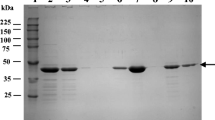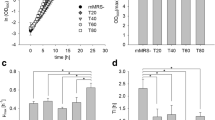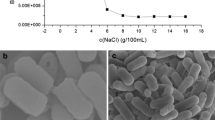Abstract
Objective
To increase the resistance of ingested bacteria to multiple environmental stresses, the role of transglutaminase in Lactococcus lactis and possible mechanisms of action were explored.
Results
L. lactis grown with transglutaminase exhibited significantly higher resistance to bile salts, stimulated gastric juice, antibiotics, NaCl, and cold stress compared to the control (cultured without transglutaminase), with no negative influence on cell growth. Transmission electron microscopy revealed that the cell walls of L. lactis cultured with 9 U transglutaminase/ml were approx. 1.9-times thicker than the control. Further analysis demonstrated that the multi-resistant phenotype was strain-specific; that is, it occurred in bacteria with the presence of glutamine and lysine in the peptidoglycan.
Conclusion
Supplementation of culture media with transglutaminase is an effective, simple, and inexpensive strategy to protect specific ingested bacteria against multiple environmental challenges.






Similar content being viewed by others
References
Bahey-El-Din M, Gahan CGM, Griffin BT (2010) Lactococcus lactis as a cell factory for delivery of therapeutic proteins. Curr Gene Ther 10:34–45
Begley M, Gahan CGM, Hill C (2005) The interaction between bacteria and bile. FEMS Microbiol Rev 29:625–651
Bui NK, Eberhardt A, Vollmer D, Kern T, Bougault C, Tomasz A, Simorre JP, Vollmer W (2012) Isolation and analysis of cell wall components from Streptococcus pneumoniae. Anal Biochem 421:657–666
Burgain J, Gaiani C, Linder M, Scher J (2011) Encapsulation of probiotic living cells: from laboratory scale to industrial applications. J Food Eng 104:467–483
Corcoles-Saez I, Ballester-Tomas L, de la Torre-Ruiz M, Prieto JA, Randez-Gil F (2012) Low temperature highlights the functional role of the cell wall integrity pathway in the regulation of growth in Saccharomyces cerevisiae. Biochem J 446:477–488
Courtin P, Miranda G, Guillot A, Wessner F, Mézange C, Domakova E, Kulakauskas S, Chapot-Chartier MP (2006) Peptidoglycan structure analysis of Lactococcus lactis reveals the presence of an l, d-Carboxypeptidase involved in peptidoglycan maturation. J Bacteriol 188:5293–5298
Fortin MH, Champagne CP, St-Gelais D, Britten M, Fustier P, Lacroix M (2011) Effect of time of inoculation, starter addition, oxygen level and salting on the viability of probiotic cultures during Cheddar cheese production. Int Dairy J 21:75–82
Fu RY, Chen J, Li Y (2005) Heterologous leaky production of transglutaminase in Lactococcus lactis significantly enhances the growth performance of the host. Appl Environ Microbiol 71:8911–8919
Gaspar ALC, de Goes-Favoni SP (2015) Action of microbial transglutaminase (MTGase) in the modification of food proteins: a review. Food Chem 171:315–322
Heidebach T, Först P, Kulozik U (2009a) Microencapsulation of probiotic cells by means of rennet-gelation of milk proteins. Food Hydrocoll 23:1670–1677
Heidebach T, Först P, Kulozik U (2009b) Transglutaminase-induced caseinate gelation for the microencapsulation of probiotic cells. Int Dairy J 19:77–84
Kawai M, Yamada S, Ishidoshiro A, Oyamada Y, Ito H, Yamagishi J (2009) Cell-wall thickness: possible mechanism of acriflavine resistance in meticillin-resistant Staphylococcus aureus. J Med Microbiol 58:331–336
Kim SJ, Chang J, Singh M (2015) Peptidoglycan architecture of Gram-positive bacteria by solid-state NMR. Biochim Biophys Acta 1848:350–362
Kuhn KS, Stehle P, Furst P (1996) Quantitative analysis of glutamine in peptides and proteins. J Agric Food Chem 4:1808–1811
Mills S, Stanton C, Fitzgerald GF, Ross RP (2011) Enhancing the stress responses of probiotics for a lifestyle from gut to product and back again. Microb Cell Fact 10(Suppl 1):S19
Pontes DS, de Azevedo MSP, Chatel JM, Langella P, Azevedo V, Miyosh A (2011) Lactococcus lactis as a live vector: heterologous protein production and DNA delivery systems. Prot Exp Purif 79:165–175
Stack HM, Kearney N, Stanton C, Fitzgerald GF, Ross RP (2010) Association of beta-glucan endogenous production with increased stress tolerance of intestinal lactobacilli. Appl Environ Microbiol 76:500–507
Wu Z, Pan DD, Guo YX, Zeng XQ (2013) Structure and anti-inflammatory capacity of peptidoglycan from Lactobacillus acidophilus in RAW-264.7 cells. Carbohyd Polym 96:466–473
Xie Y, Chou LS, Cutler A, Weimer B (2004) DNA macroarray profiling of Lactococcus lactis subsp. lactis IL1403 gene expression during environmental stresses. Appl Environ Microbiol 70:6738–6747
Zou Q, Liu X, Zhao J, Tian F, Zhang HP, Zhang H, Chen W (2012) Microencapsulation of Bifidobacterium bifidum F-35 in whey protein-based microcapsules by transglutaminase-induced gelation. J Food Sci 77:M270–M274
Acknowledgments
This work was supported by the National Natural Sciences Foundation of China (Contract No. 31200034) and the Foundation of Human Resourance of Anhui Agricultural University. We thank Dr Jeroen Hugenholtz for providing strain NZ9000 and plasmid pNZ8148.
Author information
Authors and Affiliations
Corresponding author
Rights and permissions
About this article
Cite this article
Li, Y., Kan, Z., You, Y. et al. Exogenous transglutaminase improves multiple-stress tolerance in Lactococcus lactis and other lactic acid bacteria with glutamine and lysine in the cell wall. Biotechnol Lett 37, 2467–2474 (2015). https://doi.org/10.1007/s10529-015-1942-x
Received:
Accepted:
Published:
Issue Date:
DOI: https://doi.org/10.1007/s10529-015-1942-x




